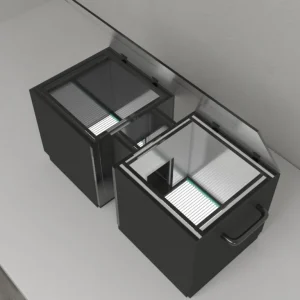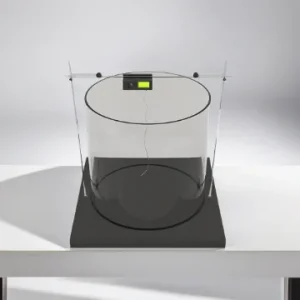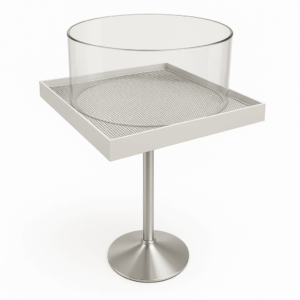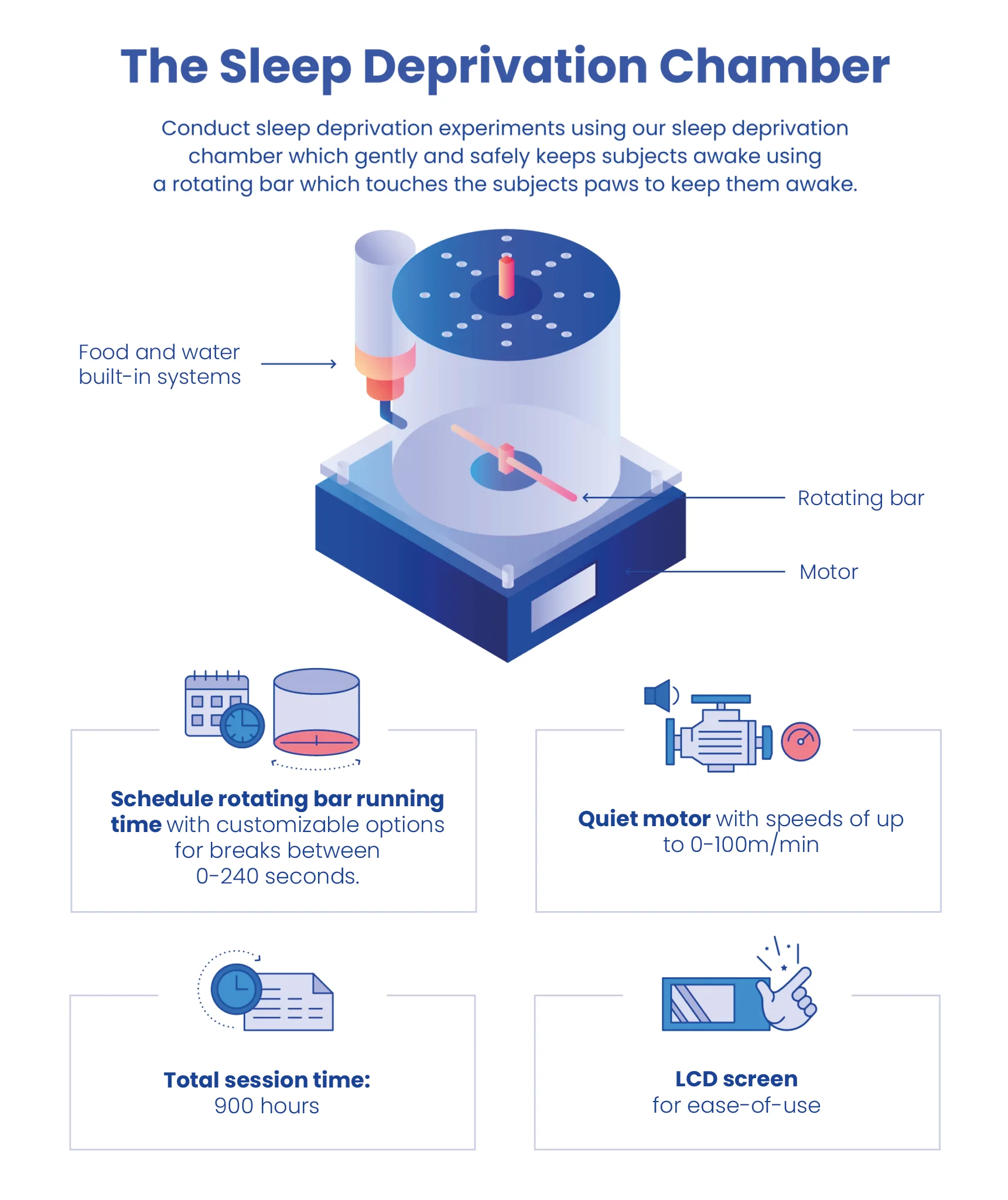$4,990.00
Sleep deprivation (SD) disrupts spatial, emotional, and working memories while increasing anxiety-like behaviors. The MazeEngineers sleep deprivation chamber model is a specialized automated system designed for rodent sleep deprivation. This device prevents REM sleep by inducing movement at intervals set by the researcher. It features a transparent acrylic chamber mounted on a motor, with a programmable screen to control the timing and rotation of an internal bar, ensuring the subject remains awake in a controlled manner. The setup includes provisions for food and water to facilitate extended studies, and lid slots are provided for the use of cables and cannulas.

MazeEngineers empowers preclinical neuroscience research with meticulously designed, customizable behavioral apparatuses. From manual classic mazes to fully automated smart systems, we provide the tools scientists need to capture high-quality, reproducible data for studies on learning, memory, anxiety, and depression.



Sleep Deprivation Chamber |
Chamber interior dimensions: 15″ x 12 “/ 38 cm x 30 cm (diameter x height) |
Dimensions can be customized upon request |
Fits up to 10 mice or 3 rats (average-sized) |
Lid slots allow for cables; cannulas for applications in optogenetics; EEG etc |

The Sleep Deprivation Chamber is an advanced automated device designed for studying sleep deprivation and fragmentation in rodents. It features a cylindrical cage with a base that contains a rotating bar. This bar gently interacts with the rodents’ feet, continuously disrupting their sleep. The rotation speed and direction of the bar can be precisely controlled via the accompanying software, and a random rotation mode is available to prevent the animals from adapting to the stimulus. The chamber’s automation reduces the need for constant human intervention.
Adequate sleep is crucial for proper human functioning, and sleep deprivation can lead to significant cognitive impairments, such as difficulty concentrating, clear thinking, and maintaining attention (Worley, 2018). In children, sleep deficits can adversely impact cognitive, physical, and socioemotional development (Schlieber & Han, 2021). Therefore, investigating the effects of sleep deprivation through rodent models can provide valuable insights into how sleep deficits influence various aspects of cognition and behavior. The Sleep Deprivation Chamber is compatible with other behavioral assessment tools like the Y-Maze and the Morris Water Maze, allowing for comprehensive studies.
Additionally, the chamber is equipped with integrated food and water systems to support long-term experiments and is spacious enough to house multiple rodents, reducing social isolation stress and enabling simultaneous sleep disruption in several subjects.
The Sleep Deprivation Chamber features a cylindrical plexiglass enclosure with a rotating bar positioned at the base. The rotation of the bar is adjustable via software, enabling precise control over both speed and direction. Users can select a moderate rotation speed ranging from 10 to 40 revolutions per minute to effectively disrupt the rodents’ sleep by making contact with their feet. An optional lid slot accommodates cannulas and cables for advanced techniques such as Optogenetics and EEG. Additionally, video tracking and analysis can be conducted using Noldus EthoVision or ANY-Maze, with camera mounts and gantries available upon request.

After each trial, ensure the cage is thoroughly cleaned and the bedding is replaced. Replenish the food and water supplies as needed.
Sleep Deprivation Procedure
To minimize social isolation stress, house the subjects in pairs within the Sleep Deprivation Chamber. Initially, subject the rats to 6 hours of sleep deprivation per day for a week. Following this, extend the deprivation period to 8 hours per day for an additional week.
This gradual increase in sleep deprivation duration is crucial, as rats’ sleep patterns during the light phase tend to increase with age.
Atrooz, Liu, Kochi, and Salim (2019) utilized the Sleep Deprivation Chamber to evaluate the effect of sleep deprivation in the early life of rats. Male Sprague Dawley rats were deprived of 6-8 hours of sleep per day for 14 days beginning at postnatal day (PND) 19. Behavioral tests were conducted at the end of the sleep deprivation task at PND 33. The Open Field Arena was used to investigate exploratory behaviors. Anxiety-like behaviors were assessed using the Light/Dark Box, the Elevated Plus Maze, and the Social Interaction Test. The Forced Swim Test was used to observe depression-like behaviors. The behavioral tests were repeated at PND 60 and 90. Anxiety-like behaviors were observed in the sleep-deprived rats at PND33 and PND60 compared to the control group. However, the subjects showed depression-like behaviors only at PND90 and not during early life. A separate set of subjects were euthanized after the sleep deprivation task for blood collection and brain dissection. Oxidative stress and inflammatory markers were evaluated. Results indicated a significant increase in oxidative stress at PND33 but not at PND90.
Naylor, Harmon, Gabbert, and Johnson (2010) evaluated whether gentling handling by the Sleep Deprivation Chamber effectively induces sleep deprivation in mice. Ten wild-type C57Bl6 mice between 11-13 weeks old were used in the study. The mice were implanted with EEG recording electrodes and EMG recording electrodes to measure sleep. The mice’s sleep was then recorded for 24 hours, followed by 24 hours of sleep deprivation and a 12 hours recovery period. The direction of the rotation bar was randomly reversed every 30-90 seconds to prevent acclimation. A yoked control mouse that was independently housed also received 24 hours of sleep deprivation but was allowed to sleep at all other times. Results indicated that the yoked control averaged three times more sleep than the sleep-deprived mice during the sleep deprivation task. The sleep-deprived group had significantly more NREM sleep than the yoked control during the recovery period.
The Sleep Deprivation Chamber induces sleep disruption in rodents through gentle, continuous contact. A rotating bar lightly touches the rodents’ feet, ensuring persistent disturbance of their sleep. Researchers can adjust the bar’s speed and direction to meet specific experimental requirements, and the option for random rotation helps prevent the animals from adapting to the stimulus. This automated system reduces the need for manual oversight and resource use compared to traditional sleep deprivation methods.
| Species | Mouse, Rat |
|---|
There are no questions yet. Be the first to ask a question about this product.